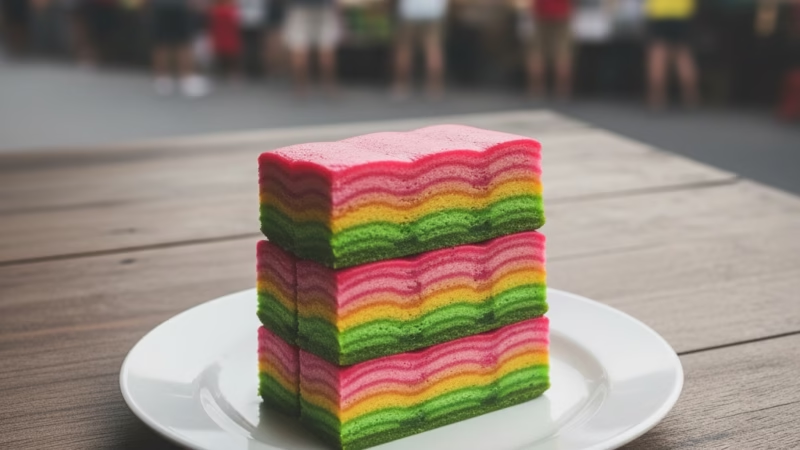Kuih Lapis Sarawak

Malaysian Food
Kuih Lapis Sarawak: Kuih Lapis Sarawak, or Kek Lapis Sarawak also called the Sarawak layer cake, kek lapis typically has a minimum of 12 layers, is a type of traditional Malaysian layered cake from the state of Sarawak, known for its vibrant, intricate patterns and soft, chewy texture. It’s made using rice flour, tapioca flour, coconut milk, sugar, salt, and food colouring. It’s made using rice flour, tapioca flour, coconut milk, sugar, salt, and food colouring.
Origin
Sarawak, Malaysia
Category
Traditional Malaysian dessert / Layered cake
Appearance
Multi-colored, translucent layers stacked neatly, usually cut into rectangular or square slices.
Ingredients
- Rice flour
- Tapioca flour
- Coconut milk
- Sugar
- Food coloring or natural coloring (pandan, butterfly pea, rose)
- Optional flavorings (vanilla, rose water)
Preparation
- Mix rice flour, tapioca flour, sugar, and coconut milk into a smooth batter.
- Divide and color the batter into portions.
- Steam each layer individually or layer by layer, allowing each layer to set before adding the next.
Equipment
- Steamer or large pot with steaming rack
- Baking tray or square mold
- Mixing bowls and spatula
Variations
- Color: rainbow, green (pandan), blue (butterfly pea), pink (rose)
- Flavor: pandan, coconut, chocolate-infused
- Mini bite-sized versions for snacks or festivals
Taste
Sweet, slightly creamy, subtle coconut flavor
Texture
Soft, chewy, slightly sticky, layered
Aroma
Fragrant coconut with hints of pandan or floral essence
Sound
Soft squish when cut or bitten
Cultural Significance
- Popular in Sarawak during festivals and celebrations
- Represents skill and tradition in local cuisine
Symbolism
The layered structure symbolizes unity, togetherness, and community
Regional Cuisine
- Indigenous to Sarawak but widely enjoyed across Malaysia
- Found in local markets, weddings, and cultural events
Social Context
- Served at family gatherings, festivals, and as a tea-time snack
Nutritional Information
- Rich in carbohydrates and fats
- Moderate sugar content
Health Benefits
- Provides quick energy
- Coconut milk supplies essential minerals
Dietary Restrictions
- Not suitable for those avoiding coconut (allergy)
- Gluten-free if using only rice and tapioca flour
Allergens
- Coconut
- Possible cross-contamination with other gluten-containing products
Cost
Affordable, sold in local markets or homemade batches
Production
Handmade or small-scale commercial; labor-intensive due to layered steaming
Sustainability
- Ingredients mostly locally sourced
- Minimal environmental impact using traditional steaming methods
Availability
Available in Sarawakian markets, specialty Malay dessert shops, and online stores
History
- Traditional Malay dessert with deep cultural roots
- Evolved from simple layered kuih to modern, colorful versions
Anecdotes
- A staple during Gawai Dayak festival
- Making it is a skillful art passed down through generations
How to Prepare
- Mix rice flour, tapioca flour, sugar, and coconut milk into a smooth batter.
- Divide and color the batter.
- Steam each layer, letting it set before adding the next.
- Cool completely, slice, and serve.
FAQ
Q: Can it be microwaved instead of steamed?
A: Traditional steaming is best; microwaving may not allow layers to set properly.
Q: How long does it last?
A: Best consumed within 2–3 days; store in an airtight container in the fridge.
Q: Is it gluten-free?
A: Yes, naturally gluten-free if only rice and tapioca flour are used.








Comments are closed.